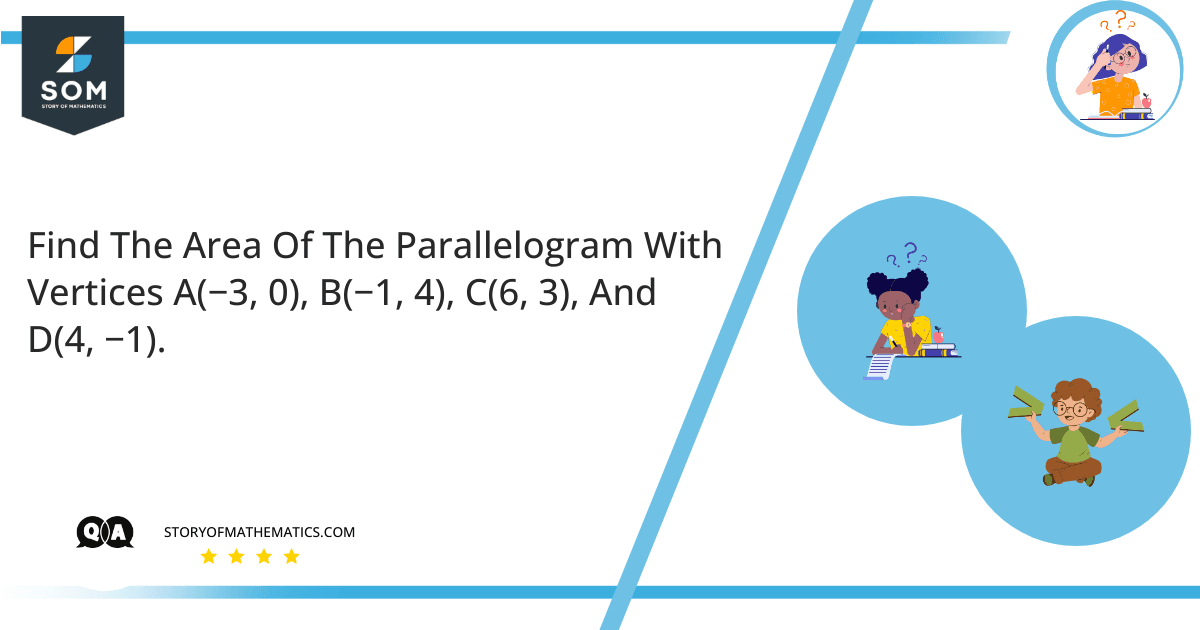
The aim of this problem is to get us familiar with the area of a very common quadrilateral known as a parallelogram. If we recall, a parallelogram is a pretty simple quadrilateral with two couples of parallel-faced sides.
The opposite lengths of a parallelogram are of equal dimensions and the opposing angles of a parallelogram are of equal magnitude.
Expert Answer
Since a parallelogram is a tilted rectangle, all of the area formulas for known quadrilaterals can be used for parallelograms.
A parallelogram with one base $b$ and height $h$ can be separated into a trapezoid and a triangle with a right-angled side and can be shuffled into a rectangle. This implies that the area of a parallelogram is identical to that of a rectangle which has the same base and height.
We can define the area of a parallelogram as the absolute magnitude of the cross product of its adjacent angles, that is:
\[Area = |\overline{AB} \times \overline{AD}|\]
Finding the adjacent edges $\overline{AB}$ and $\overline{AD}$ and substituting back in the equation as follows:
\[\overline{AB} = B – A \]
Point $A$ and $B$ are given as:
\[\overline{AB} = (-1, 5) – (-3, 0) \]
\[= (-1+3) , (5 – 0)\]
\[\overline{AB} = (2, 5)\]
Now solving $\overline{AD}$:
\[\overline{AD} = D – A\]
Point $A$ and $D$ are given as:
\[\overline{AD} = (5, -1) – (-3, 0)\]
\[= (5+3) , (-1 + 0)\]
\[\overline{AD} = (8, -1)\]
Finding the cross product of $\overline{AB}$ and $\overline{AD}$ as:
\[ \overline{AB} \times \overline{AD} = \begin{bmatrix} i & j & k \\ 2 & 5 & 0\\8 & -1 & 0 \end{bmatrix}\]
\[= [5(0) – 0(-1)]i – [2(0)-0(8)]j +[2(-1)-5(8)]\]
\[= 0i +0j -42k\]
Taking the magnitude of $\overline{AB}$ and $\overline{AD}$, as the formula states:
\[Area = |\overline{AB} \times \overline{AD}|\]
\[= |0i+ 0j -42k|\]
\[= \sqrt{0^2 + 0^2 + 42^2}\]
\[= \sqrt{42^2}\]
\[Area= 42\]
Numerical Result
The area of the parallelogram with its vertices $A(-3,0)$, $B(-1,5)$, $C(7,4)$ and $D(5,-1)$ is $42$ Square Unit.
Example
Find the area of the parallelogram given the vertices $A(-3,0)$, $B(-1,4)$, $C(6,3)$ and $D(4,-1)$
Inserting the values into the formula of parallelogram, which is given as:
\[Area = |\overline{AB} \times \overline{AD}|\]
Finding the $\overline{AB}$
\[\overline{AB} = B – A\]
Point $A$ and $B$ are given as:
\[\overline{AB} = (-1, 4) – (-3, 0) \]
\[= (-1+3) , (4 – 0) \]
\[\overline{AB} = (2, 4)\]
Now solving $\overline{AD}$:
\[\overline{AD} = D – A\]
Point $A$ and $D$ are given as:
\[\overline{AD} = (4, -1) – (-3, 0) \]
\[= (4+3) , (-1 + 0) \]
\[\overline{AD} = (7, -1)\]
Finding the cross product of $\overline{AB}$ and $\overline{AD}$ as:
\[\overline{AB} \times \overline{AD} = \begin{bmatrix} i & j & k \\ 2 & 4 & 0\\7 & -1 & 0 \end{bmatrix}\]
\[= [5(0) – 0(-1)]i – [2(0)-0(8)]j +[2(-1)-4(7)]\]
\[ = 0i +0j -30k \]
Taking the magnitude of $\overline{AB}$ and $\overline{AD}$, as the formula states:
\[Area = |\overline{AB} \times \overline{AD}|\]
\[= |0i+ 0j -30k|\]
\[ = \sqrt{0^2 + 0^2 + 30^2}\]
\[ = \sqrt{30^2}\]
\[ = 30\]
The area of the parallelogram with vertices $A(-3,0)$, $B(-1,4)$, $C(6,3)$ and $D(4,-1)$ is $30$ Square Unit.
